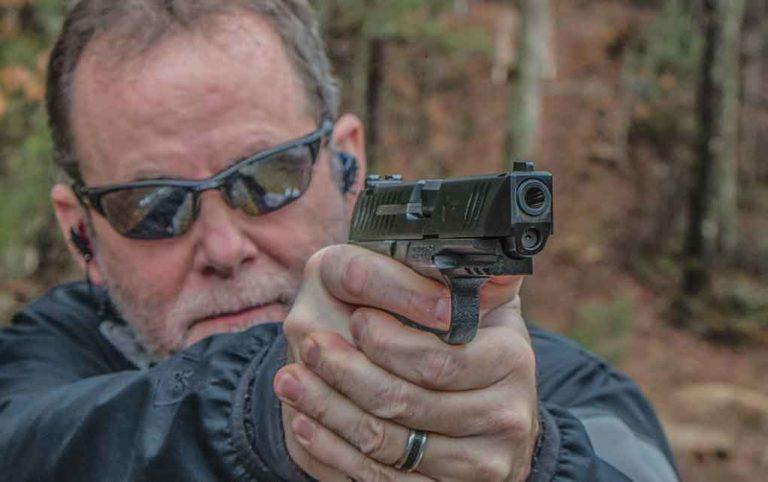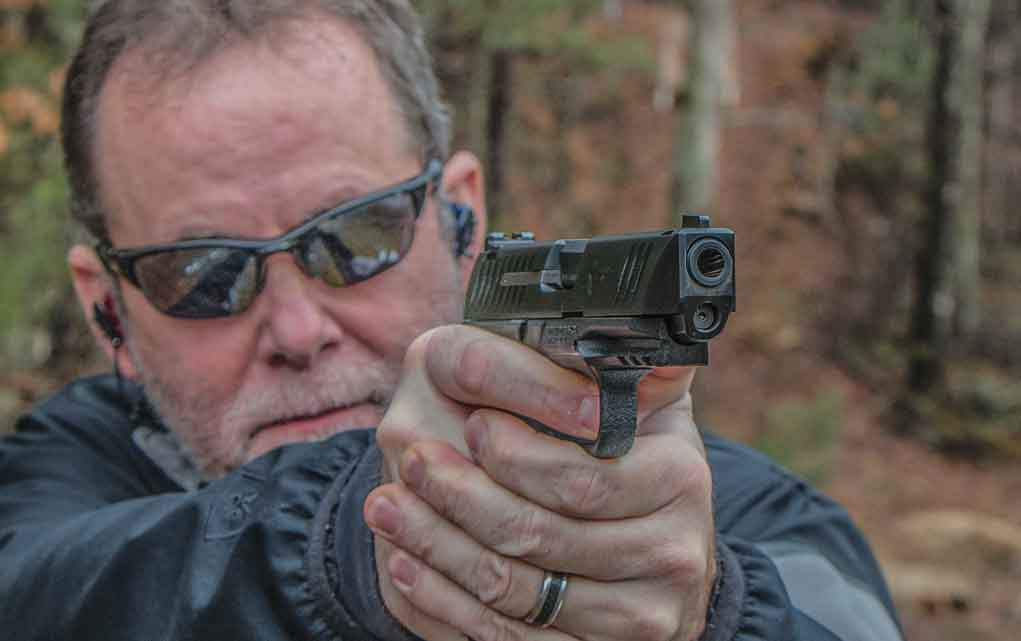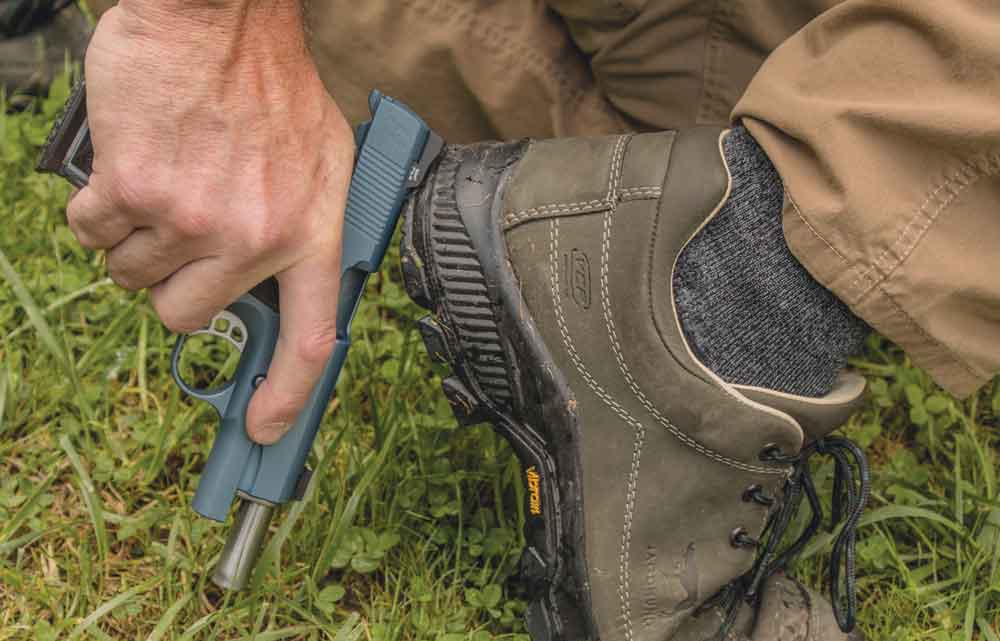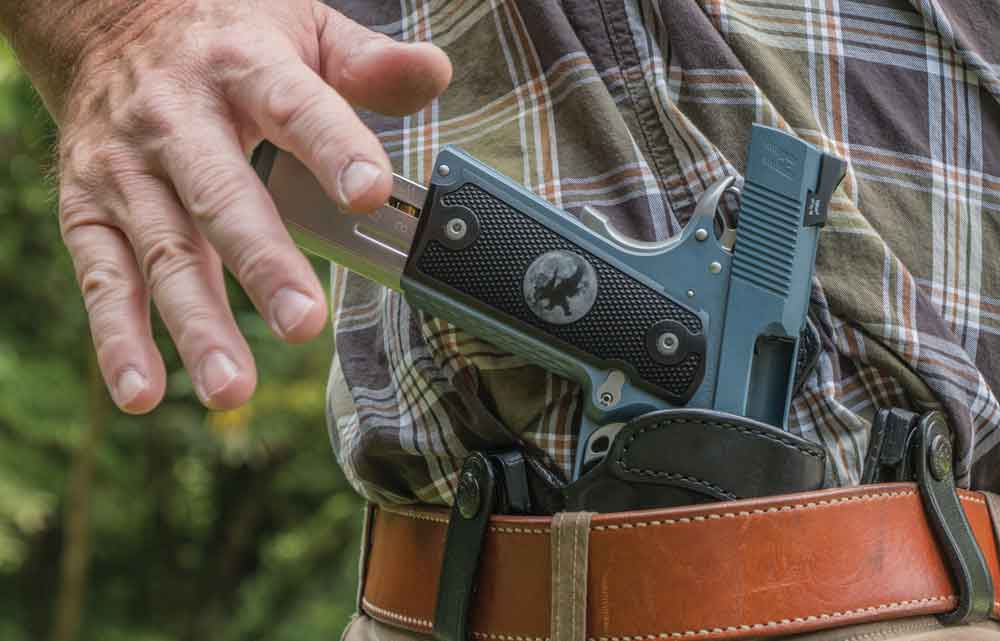
Most handgun drills are universal, applying to both semi-automatic pistols and revolvers. But there are a few more facets that need to be mastered when becoming proficient with a pistol.
The essential training drills for your semi-auto pistol.
Drills used to improve or test your ability with a defensive handgun are generally universal in nature. Most are structured to apply equally, whether you’re shooting a revolver or semi-auto pistol. Skills such as sight alignment, trigger control, tactics and basic safety practices are, for the most part, general in nature.
The big difference with the semi-auto pistol relates to firearms manipulation, or “weapon-craft.” Shooting speed and accuracy are critical, but you must be able to run your gun. Here are a couple drills to help you become faster and more accurate with your semi-auto pistol.
The Reload Drill

You’ve probably heard the old gunfighter advice to count your rounds in a gunfight so you know when to reload. Considering that top-level professional shooters often have trouble with simple math in high-stress situations, after the shooting starts, you’ll be lucky if you have any idea how much ammunition is in your gun at any given point. This drill will help you keep your gun in the fight.
Fully load two magazines. Load your pistol, and place the other magazine in your mag pouch. Using a shot timer, at the start signal, fire one shot at a target positioned at about 3 yards. (We’re testing reloading speed, not accuracy.) After the shot, immediately reload your pistol while letting the discarded magazine drop to the deck. Once reloaded, fire another round at the target. The time between shots — your split time — is how long it took you to reload your weapon.
How fast should you be? The answer: as fast as possible. No matter how fast you can do it, it’s not fast enough. Keep track of your performance and work to improve during every trip to the range. A 50-round box of ammo will give you 25 iterations of this drill, and you might consider doing it as frequently as every other time you’re at the range. (Editor’s note: For more information on reloading drills, see “Rules For Record-Time Reloads” in the Fall 2017 issue of GDTM.)
Tactical Notes
Many firearms instructors have overcomplicated the entire reloading process. They have speed reloads, tactical reloads — and they even argue about the circumstances that dictate when each should be performed. When I was the firearms instructor at my department, I only got to work on the range with the officers twice each year. That was sad, but so is the fact that most carrying for personal protection get about the same range time. Given that, I developed doctrine to keep it simple. After all, simple solutions are always good in stressful situations.

I didn’t try to teach officers to count shots. Our Glocks held lots of ammo, so our protocol was to shoot until you thought you needed to reload or shoot until you had to reload. Either way, any time you inserted a new magazine into your pistol, you racked the slide. The beauty of this approach is that if your gun quit working because of a stoppage, a reload and slide cycle would most likely sort the problem out. If it stopped because it was empty, the reload would most definitely correct the problem.
Yes, if you’ve conducted a reload with a live round in the chamber, you’re sacrificing that round to ensure your gun is ready to run. But keep this in mind: Just because your gun is not at slide lock does not mean it has a round in the chamber. You could have possibly inhibited the proper action of the slide lock when the last round in the magazine was fired, or it might have malfunctioned. Unless you train on a weekly or at least monthly basis, consider keeping the reloading process simple. If you dedicate the necessary time, there’s a place for a more comprehensive approach, but it’s not a necessity.
One-Hand Manipulation Drill

You might end up injured during a fight, or maybe you only have one arm or one functioning hand to begin with. Or, you might be using one arm or hand to navigate with a light or usher family members to safety. Either way, you’re at a disadvantage, and, like everyone in Africa says, you need to, “make a plan.” You can shoot and tend to a semi-automatic pistol with one hand; it’s just something that takes a good bit of practice.
Like the previous drill, fully load two magazines: Load the gun, and place the other magazine in your mag pouch. Now, using one hand, fire a shot at a target and then eject the magazine in the pistol. Next, holster the pistol, retrieve the other magazine, and insert it into the mag well. Now you must establish a shooting grip, draw the handgun, and then, using your belt or the heel or sole of your shoe, cycle the slide and engage the target.
Tactical Notes

Some instructors will argue this is a great reason for using your thumb on the slide lock to release the slide, but there’s a problem with this approach: If the pistol is in your strong hand, you might be able to execute this technique. However, if you’re manipulating the pistol with your weak hand — your strong hand could be the injured hand — and because most slide locks are on the left side of pistols, you’ll likely struggle to depress the slide lock. Additionally, the reason you might need to be fiddling with your pistol at all is because of a stoppage, not an absence of ammo. In that instance, you’re going to need to cycle the slide to help ensure clearance of the stoppage.
High-Cap Hammer-Time Drill
One of the main advantages of a semi-auto pistol over a revolver is capacity. Unless you’re dealing with an ultra-compact handgun or one with a single-stack magazine, you’re likely to have as much as 12 to 16 rounds on board. This is a good thing when you’re trying to stop a meth-crazed fiend from filleting you with a rusty blade. So, let’s take advantage of it.

Most defensive handgun training drills utilize some rendition of the double-tap — two quick shots to center mass — or two shots to the body and one to the head. I’m not suggesting anything is wrong with either, but might it be a good idea to continue to shoot the threat until it is no longer a menace?
If you were faced with a charging lion, I’ll guarantee you’d not shoot twice and then consider your situation — you’d shoot until you were sure those teeth and claws were no longer bound for your body. This drill will help you to continue to accurately pour lead into your target as you also create or reduce distance.
Place a target at about 2 yards. At the start signal, draw and begin shooting as you quickly move backward. You should be able to cover between 3-4 yards by the time you’ve fired six to eight shots. Once at that distance, slip behind cover, step back out the same side or the other side, and repeat the exercise in reverse, firing six to eight shots as you advance on the target, only reloading after the drill is complete.
Tactical Notes
It’s important to keep this drill in context. It might or might not be something you’d ever replicate in a real life situation. Of course, predicting what will happen in a hostile encounter is even less accurate than weather forecasts. However, it’s hard to dispute the need to be able to deliver multiple rounds on target fast, potentially while moving forward or backward to create distance or obtain cover.
As one of my professional hunter friends in Africa likes to say, “The big thing is,” semi-auto pistol cartridges like the 9mm, .40 S&W and .45 Auto are not reliable fight stoppers. So, the more internal damage you can inflict, the likelier it is a “stop” will result. Remember, shooting the bad guy is not enough — you have to stop them.
Editor's Note: This article originally appeared in the September 2017 issue of Gun Digest the Magazine.

Next Step: Get your FREE Printable Target Pack
Enhance your shooting precision with our 62 MOA Targets, perfect for rifles and handguns. Crafted in collaboration with Storm Tactical for accuracy and versatility.
Subscribe to the Gun Digest email newsletter and get your downloadable target pack sent straight to your inbox. Stay updated with the latest firearms info in the industry.

![Best Concealed Carry Guns In 2025 [Field Tested] Wilson Combat EDC X9S 1](https://gundigest.com/wp-content/uploads/Wilson-Combat-EDC-X9S-1-324x160.jpg)


![Best 9mm Carbine: Affordable PCCs [Tested] Ruger Carbine Shooting](https://gundigest.com/wp-content/uploads/Ruger-Carbine-Shooting-100x70.jpg)
![Best AR-15: Top Options Available Today [Field Tested] Harrington and Richardson PSA XM177E2 feature](https://gundigest.com/wp-content/uploads/Harrington-and-Richardson-PSA-XM177E2-feature-100x70.jpg)

In your one hand manipulation drill, you state: “fully load two magazines: Load the gun, and place the other magazine in your mag pouch. Now, using one hand, fire a shot at a target and then eject the magazine in the pistol. Next, holster the pistol, retrieve the other magazine, and insert it into the mag well. Now you must establish a shooting grip, draw the handgun, and then, using your belt or the heel or sole of your shoe, cycle the slide and engage the target.” Once you fire one round, the pistol will cycle, and load another. When you drop your magazine, and reload a fresh one, you are already loaded and ready to go – why rack the slide, unless you have a malfunction of some type? I will not be practicing this drill….